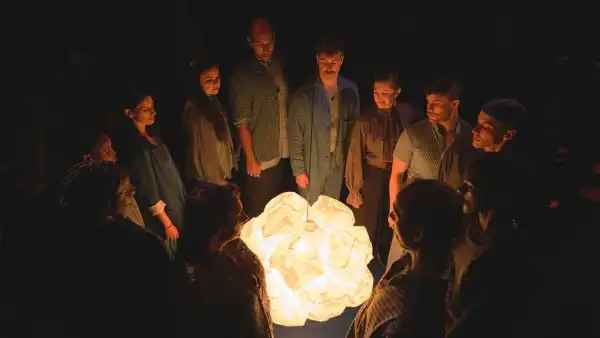
Save this storySave this storySave this storySave this story
The prior occurrence of composer Heather Christian’s “Oratorio for Living Things” on a New York stage was in the spring of 2022, when the act of assembling still seemed somewhat daring. Some of us had anticipated it for years: Ars Nova initially endeavored to present “Oratorio,” a continuous musical work, partially in Latin, exploring the “sacred” concept of time, at Greenwich House, in 2020, but the pandemic halted it. Two years hence, Christian’s composition for a dozen voices returned, seemingly honed to a diamond-like sharpness by the prolonged hiatus. During that initial hesitant season post-shutdown, “Oratorio” was presented in deliberately close confines, its audience packed onstage in a compact oval of risers, while the chorus, adorned in blue, ascended to perform before, above, behind, and beside them. The presentation was sublime—a rare, almost-religious, non-narrative, partly-Latin in-demand event—but when a few company members contracted COVID, Ars Nova was compelled to axe the final week of showings.
Now the stunning “Oratorio” has resurfaced, this time at the Signature. Lee Sunday Evans once more helms the production, a significant portion of the original company (including a petite orchestra) has rejoined, and Krit Robinson’s wooden oval returns, in a somewhat expanded form. The tiered area, once again imbued with a profound indigo by lighting designer Jeanette Oi-Suk Yew, evokes a ship’s cargo area, or perhaps a surgery room at dusk. Within this dimly lit blue expanse—Christian, in conversation, describes blue as the hue of “profound time”—Robinson suspends an odd illumination, a bulbous paper pendant resembling a portion of popcorn yet emitting light akin to the sun, or potentially the nucleus of a magnified particle.
Unless you possess fluency in impromptu Latin, the initial segment of “Oratorio” may seem baffling. However, with attentive listening, patterns materialize, followed by a sudden flash of comprehension as the vocalists transition into English. Mere days before this restaging debuted, Christian garnered a MacArthur Fellowship for “crafting a space to contemplate the sacred.” Her discourse here centers on time’s relentless progression, consequently the lyrics occasionally depict natural phenomena, such as the cyclical motion of water between surface and atmosphere, or the duration we dedicate to a given commonplace action throughout life: “ten minutes providing incorrect directions to strangers”; “nine days awaiting a reply.” A compilation of initial recollections, a reflection on decay, whirling constellations—each verse delves into change on a personal or cosmic dimension. One solitary sequence, rendered with a delicate, weathered tone by Dito van Reigersberg, envisions hydrogen and helium as progenitors whose turbulent interactions yield everything in existence.
Christian’s composition incorporates numerous genres we link to ritual, be it sacred or secular. Within her intricately fugal structures, we discern allusions to high-church chant, Quaker plainsong, Steve Reich’s “Clapping Music,” Carl Orff’s “Carmina Burana” (alongside his schulwerk variations), and a spirited Baptist choir. She has maintained a longstanding fascination with canon and recurrence—her musical adaptation of Gertrude Stein’s “The World Is Round” (“Rose is a Rose is a Rose”) secured an Obie in 2014, and she supplied the music for a video piece during the shutdown era, “I Am Sending You the Sacred Face,” wherein she sang all roles, employing loops to harmonize with herself. When Christian vocalizes, her tone resonates with a mournful, blues-tinged inflection. Yet, in her compositions for others, the work conveys a sense of urgency rather than sorrow. Frequently, an ascending complex melody will stabilize into a solitary, persistent note; tempos quicken and then accelerate anew; her singers abandon lyrics to keen like alarms. The initial sixty minutes of “Oratorio” yield a remarkable impact. Overwhelmed, I experienced the sensation of being the resonating component within a colossal, sonorous bell.
Then why did “Oratorio” ultimately evoke a sense of melancholy in me? Recurrence, Christian informs us, serves as the vehicle for both assessment and significance, and throughout “Oratorio” I became preoccupied with the subtle variances between this rendition and the earlier, seemingly equivalent one from 2022. (To all things there exists a season, and perhaps the pandemic, curiously, complemented “Oratorio.”) Evans has once more guided the performers to smile often, to establish eye contact with us as they perform. Three years prior, this lent them the appearance of fellow parishioners exchanging greetings across the pews, but now a shift has occurred—perhaps our heightened sense of crisis, maybe their increased degree of refinement—and that seamless affability can appear somewhat saccharine. As the presentation progresses beyond its splendid initial hour, the concluding thirty minutes lean toward the excessively sweet. “If you’re present, you must transform,” someone articulates, and at that instant it struck me as more akin to Sunday school than Sunday service.
Christian has long held an interest in the church timepiece, and she has authored several pieces celebrating the ancient canonical hours, including the remarkable “Terce,” from 2024, intended for performance at nine in the morning, and the streamable “Prime,” which merits listening at 6 A.M. Adhering to the breviary’s rationale, I posit that “Oratorio” should be revisited at established intervals; each iteration will inevitably alter it anew. Even now, I am contemplating the astounding commencement of the presentation, which is somehow superseding my recollection of the less satisfying conclusion. Time advances inexorably, Christian’s text declares, which constitutes her iteration of the good tidings. “We occupy the middle,” Christian assures us. “We aren’t situated at the conclusion / of a cycle.”
A notably distinct form of pseudo-church ceremony unfolds within “Oh Happy Day!,” Jordan E. Cooper’s own Biblically influenced composition, currently staged downtown at the Public. A vexing yet intermittently exquisite production, overseen by Stevie Walker-Webb, it functions as a type of devotion-for-one—a simultaneous immersion, return of the prodigal, and apotheosis for Cooper himself.
The playwright and performer, who received a Tony nomination for “Ain’t No Mo’ ” two seasons ago, portrays Keyshawn, a man who has returned home under duress: in actuality, he has recently passed away, but his spirit must fulfill an obligation before attaining his reward. Abandoned to the streets as an adolescent, long disregarded by his prejudiced father (Brian D. Coats), and estranged from his sister, Niecy (Tamika Lawrence), and her offspring, Kevin (Donovan Louis Bazemore), Keyshawn has been divinely commanded to somehow save them all from a deluge (the upper case is implied), poised to inundate their community in Laurel, Mississippi. Keyshawn seethes, naturally, that God expects him to disregard his entirely justifiable grievances in order to preserve his kin. Why did his father never seek him out, especially upon discovering that Keyshawn had resorted to sex labor to subsist? Yet God, manifesting in the guise of each member of Keyshawn’s family, refuses to entertain “no” as a response.
The presentation is narrated by three angelic “Divines” (Tiffany Mann, Sheléa Melody McDonald, and Latrice Pace), adorned in shimmering violet evening attire. (Qween Jean conceived the costumes, some of which, amusingly, illuminate.) The Divines uplift Keyshawn’s spirits by performing several original compositions penned by gospel composer Donald Lawrence, who ingeniously incorporates the lexicon of theatrical performance into his lyrics. “If your wish is to change what you’re seeing . . . reset!” the Divines vocalize, as vibrant as the trumpets at Jericho, while Keyshawn reconfigures the theatre props—for instance, a chair he has just hurled across the yard—to reattempt a particular family interaction. The play, too, reiterates its gestures, at times tiresomely: Keyshawn repeatedly throws himself against his family’s insensitivity, whereupon a vision of God reprimands him. The intended outcome is Keyshawn’s eventual tearful collapse. Fortunately, the vocalizations are present to elevate the remainder of us, up, up, up.
It is notable that an abundance of theatre-but-make-it-church material has emerged this autumn. New York Theatre Workshop recently staged “Saturday Church,” a Sia musical showcasing a queer ballroom rendition of a service, wherein J. Harrison Ghee officiates as Black Jesus and the dancers routinely divest themselves of their choir robes; Playwrights Horizons recently debuted Jen Tullock’s solo play “No One Can Take You from the Hand of God,” concerning a woman who abandons her oppressive religious upbringing only to concede that she yearns for her faith. And at Ars Nova, the resplendent “pastor’s kid” writer-performer Brandon Kyle Goodman embodies both preacher and exuberant sex educator (envision a Mr. Rogers who dons both a cardigan and fetish attire) in the deliriously sex-positive “Heaux Church.” Their doctrine encompasses cheerful instructional interludes featuring puppet genitalia—Floppy, the purple penis, grapples with sentiments of shame—and ample congregational engagement, including some tactile instruction employing glazed confections.
One cannot brandish a censer in this locale currently without encountering someone who, while raised within the Christian church, feels alienated from the service as it exists. It is no coincidence that numerous projects constitute explicitly queer reclamations of its frameworks and embellishments. All discover merit in its musical customs. (One joyous sound can resemble another.) We are clearly in a period of intense spiritual seeking, and it is significant that many have unearthed resolutions within the theatre. In “Oh Happy Day!,” Keyshawn struggles to comprehend the source of materials for an ark until he observes the ease with which his father’s residence can be dismantled. The timber for a new edifice lies before him; his sole requirement is to demolish the antiquated structure and construct something novel. ♦
Sourse: newyorker.com






